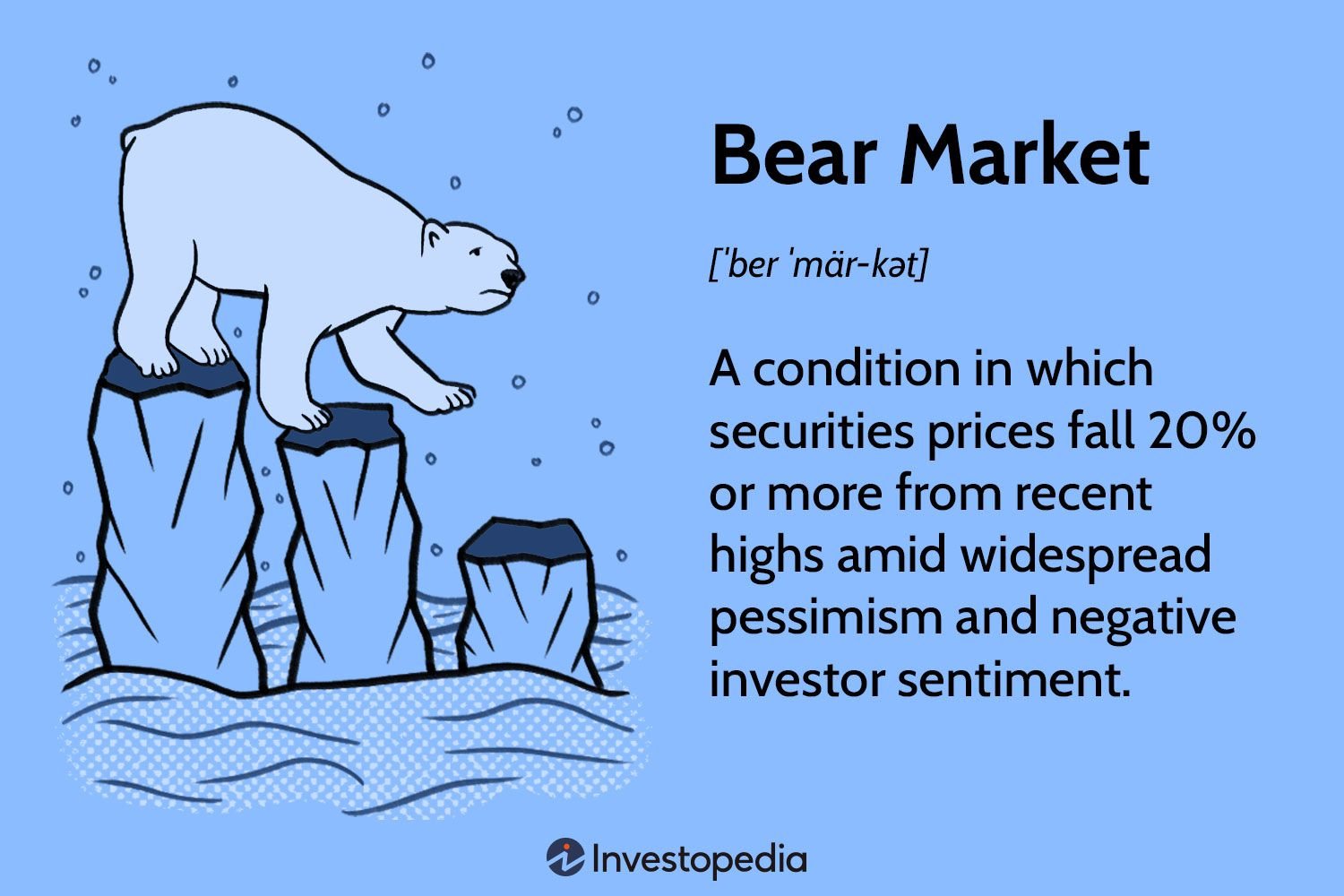Bear markets can be intimidating, especially for new investors. The sudden downturn in market confidence can make even the most seasoned investors question their strategies. But fear not! Understanding bear markets and how to invest during these challenging times is not as daunting as it may seem. In this article, we’ll dive into the world of bear markets, unraveling their complexities, and providing you with practical tips on how to navigate through them successfully. So, if you’re ready to grasp the concept of bear markets and learn how to make informed investment decisions, you’ve come to the right place. Let’s get started!
Understanding Bear Markets and How to Invest
Introduction
In the world of finance, bear markets can be intimidating and confusing for investors. The term “bear market” refers to a period of time when the prices of stocks, bonds, or other financial instruments are falling, and pessimism dominates the market. Understanding bear markets and knowing how to invest during these challenging times is crucial for long-term financial success.
What is a Bear Market?
A bear market is typically characterized by a sustained decline in market prices, often accompanied by negative investor sentiment. It is the opposite of a bull market, which is characterized by rising prices and optimistic investor sentiment. Bear markets can occur in various financial markets, including stocks, bonds, commodities, and currencies.
During a bear market, investors become cautious and may choose to sell their investments, leading to a further decline in prices. This pessimistic sentiment is often fueled by economic downturns, geopolitical uncertainties, changes in government policies, or market bubbles bursting.
Signs of a Bear Market
Identifying the signs of a bear market can help investors make informed decisions and better navigate through challenging times. While it can be challenging to predict the timing and severity of a bear market, there are several indicators that can suggest a potential downturn:
1. Market Index Decline: A significant and sustained decline in a broad market index, such as the S&P 500, may indicate the start of a bear market.
2. Investor Sentiment: Heightened pessimism and negative sentiment among investors can be a sign of an impending bear market. Increased fear, uncertainty, and anxiety about the economy and future returns are common during these times.
3. Economic Indicators: Negative economic indicators, such as rising unemployment rates, declining GDP, or slowing consumer spending, can contribute to the onset of a bear market.
4. Volatility Increase: Increased market volatility, as measured by indicators like the VIX (CBOE Volatility Index), can signal a bear market. Higher volatility reflects increased uncertainty and fear within the market.
How to Invest in Bear Markets
While bear markets can be challenging, they also present unique investment opportunities for those who approach them with a strategic mindset. Here are some strategies to consider when investing during a bear market:
1. Diversify Your Portfolio
Diversification is a key principle of investing that helps reduce risk by spreading investments across different asset classes, industries, and geographies. During a bear market, diversification becomes even more critical as it allows you to minimize losses by having exposure to various investment options. Consider allocating your portfolio across stocks, bonds, commodities, and cash to reduce the impact of market downturns.
2. Invest in Defensive Stocks
Defensive stocks, also known as non-cyclical stocks, are shares of companies that tend to perform well, or at least, hold their ground during economic downturns. These companies typically operate in industries such as healthcare, consumer staples, utilities, and essential services, which are less affected by economic volatility. Investing in defensive stocks can provide stability to your portfolio during a bear market.
3. Dollar-Cost Averaging
Dollar-cost averaging is an investment strategy that involves regularly investing a fixed amount of money, regardless of market conditions. This approach allows you to buy more shares when prices are low and fewer shares when prices are high. By consistently investing over time, you can take advantage of market downturns and potentially lower your average cost per share.
4. Consider Bonds and Fixed-Income Investments
During bear markets, investors often seek safer investments that provide stable income and lower risk than stocks. Bonds and other fixed-income investments, such as Treasury bonds, corporate bonds, or bond mutual funds, can offer a steady stream of interest income and potentially preserve capital. These investments can serve as a defensive component in your portfolio during uncertain times.
5. Stay Informed and Be Patient
Keeping yourself informed about market conditions and the underlying factors impacting the bear market is essential. Stay updated on economic indicators, company news, and market trends to make informed decisions. It’s also important to remain patient during a bear market. Markets tend to go through cycles, and eventually, they recover. Avoid making impulsive investment decisions based on short-term market movements and keep a long-term perspective.
Understanding bear markets and knowing how to invest during these challenging times is crucial for investors looking to navigate through periods of market decline. By diversifying your portfolio, investing in defensive stocks, practicing dollar-cost averaging, considering bonds and fixed-income investments, and staying informed while maintaining patience, you can position yourself for long-term financial success.
Investing during bear markets can be intimidating, but it’s important to remember that market downturns also present unique opportunities. By adopting a strategic and disciplined approach, investors can weather the storm and potentially benefit from the eventual market recovery.
PAST BEAR MARKETS & How To Profit From Them
Frequently Asked Questions
Frequently Asked Questions (FAQs)
What is a bear market?
A bear market refers to a period in the financial market where prices of securities, such as stocks, are falling or anticipated to fall. It is characterized by a pessimistic sentiment among investors, causing them to sell stocks and other investments, further driving down prices.
How long do bear markets typically last?
The duration of a bear market can vary. Historically, bear markets have lasted anywhere from a few months to a couple of years. However, it is challenging to predict the exact duration as it depends on various factors such as economic conditions, market sentiment, and policy interventions.
What causes bear markets?
Bear markets can be triggered by a range of factors, including economic recession, geopolitical events, interest rate hikes, and negative investor sentiment. These factors can lead to a decline in corporate earnings, increased unemployment rates, and a lack of consumer confidence, resulting in a downward spiral in the market.
How can I protect my investments during a bear market?
While it is impossible to completely shield investments from the effects of a bear market, there are strategies you can employ to mitigate losses. Diversifying your portfolio, investing in defensive sectors, such as healthcare or utilities, and utilizing stop-loss orders are some methods to help protect your investments during bear markets.
Should I sell my investments during a bear market?
The decision to sell investments during a bear market depends on your individual circumstances and investment goals. While panic selling is generally not advised, it may be necessary to reassess your investment strategy and consider selling if your financial goals have changed or if a particular investment no longer aligns with your long-term objectives.
Are there any investment opportunities during a bear market?
Yes, bear markets can present opportunities for investors. During market downturns, some quality stocks may become undervalued, offering a chance to buy them at a lower price. Additionally, commodities like gold, which tend to perform well during economic turbulence, can be attractive investment options.
What is the difference between a bear market and a correction?
A bear market is a more severe and prolonged decline in the market, typically spanning a longer period and resulting in a significant drop in prices. On the other hand, a correction refers to a temporary decline, usually around 10% from recent highs, within an overall upward-trending market.
How can I stay informed about bear markets and investment strategies?
To stay informed about bear markets and investment strategies, consider following reputable financial news sources, reading books or articles on investing, and consulting with financial advisors. It is essential to continuously educate yourself and remain up-to-date with market trends to make informed investment decisions.
Final Thoughts
Understanding bear markets and how to invest is crucial for successful financial management. In a bear market, stock prices decline significantly, leading to widespread pessimism and decreased investor confidence. To navigate these challenging times, investors should adopt a long-term perspective, diversify their portfolios, and focus on quality investments. They should also stay informed about market trends, monitor their investments regularly, and consider seeking professional advice when needed. By following these strategies, investors can position themselves to withstand the volatility of bear markets and potentially make profitable investments. Understanding bear markets and how to invest is an essential skill for anyone looking to navigate the ups and downs of the financial market.



